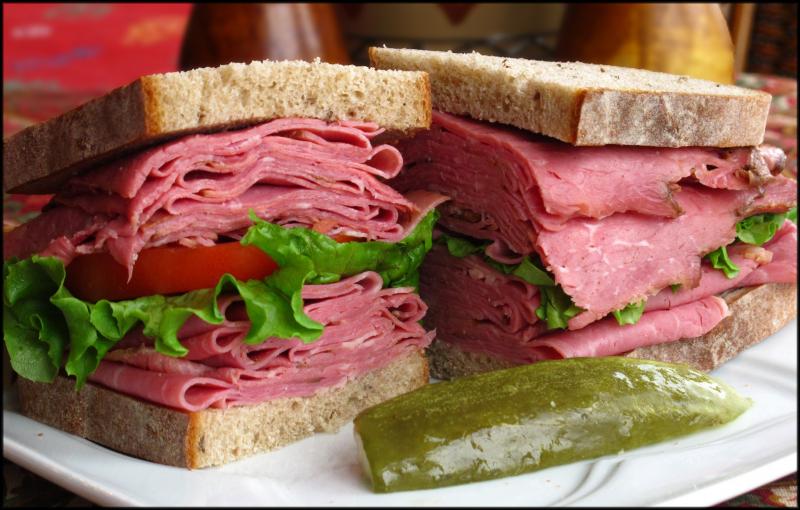Explore the appeal of pastrami
Whenever we travel to New York City to see a show or visit a museum, we always make a trip up Seventh Avenue for a pastrami sandwich at the Carnegie Deli. If you’ve ever been there, you may understand the appeal. And if you’ve never been there, you’re out of luck: Carnegie Deli, across from Carnegie Music Hall for nearly 80 years, closed its doors this past December.
The menu featured all the Jewish-deli favorites, from knishes to matzoh ball soup, along with a dazzling array of sandwiches. What made these sandwiches so memorable was that they were stacked with close to an entire pound of sliced meat. One look at the plate and you were glad you’d planned in advance to share half.
What exactly is pastrami? Although we may think of it as a specific type of meat, the name actually refers to a technique of brining, curing and smoking to create the signature flavors and color of pastrami. When done correctly, the exterior of the meat is thickly crusted, and the interior is tender and pink.
Most food historians believe that today’s pastrami originated as a Romanian method for preserving mutton or lamb. Some cite the Romanian word pastrama as meaning “to keep” while others claim it refers to a dish of goose breast preserved with salt and smoke.
In the second half of the 19th century, when Jewish immigrants brought the recipe to this country, the goose, lamb or pork was replaced with beef, which was more readily available and conformed to kosher dietary laws. The time-consuming steps to making pastrami resulted in the signature taste and texture of delicious meat.
Both pastrami and corned beef begin the same way, with a cut of beef called the brisket, a heavily muscled region in the lower part of the cow’s chest. The brisket is initially soaked for several days (sometimes weeks) in a salty brine, heavily seasoned with sugar and pickling spices. Before we had refrigeration, this was the preferred way to preserve meat from spoiling.
Once the meat is cured, it has the bright color that comes from the pink curing salt (sometimes sold as Prague powder or cure-all). At this point you have created a corned beef brisket, which you can heat, slice and serve. Or, you can proceed to transform it into pastrami.
The key difference between corned beef and pastrami is the smoking step. For this, the meat is coated with a dry rub made from a combination of spices, the most important of which are coriander and black pepper. After it has been smoked, the pastrami is ready to eat, although some prefer to steam the pastrami just before slicing and serving.
What’s missing in the pastrami from your grocery deli counter or other upscale purveyor is the heat. Pastrami is stored under refrigeration and sold chilled. If you want to replicate the Carnegie Deli experience, you’ll need to heat the pastrami, preferably by steaming it.
Because it’s sliced thin, pastrami does not exit the skillet in good shape if you try to sauté it in butter or brown it dry. Instead, tightly wrap the pastrami slices in aluminum foil, and place the packet in a colander set over a large pot of boiling water. Here, it will be gently steamed until heated completely through.
While making your own pastrami isn’t difficult, it can be time-consuming. There are a number of places in our area that serve good pastrami, and, as it happens, Carnegie Deli isn’t completely off the map. It has licensed locations in Las Vegas, Bethlehem, Pa., a pop-up that operates during the U.S. Open Tennis Championships and a concession stand in Madison Square Garden.
I’ve included a recipe adapted from Michael Ruhlman’s website that takes you through the brining details and his process of smoking, baking and steaming. Some cooks recommend starting with a commercially packaged corned beef brisket, but the curing agents tend to be overly salty, so either do it all yourself or buy it ready to heat and eat.
For us, the best way to enjoy pastrami is on sliced seeded rye from Old World Breads. And, as seen in the photo, we limited the amount of pastrami to just 10 ounces, instead of a full pound of meat.
Michael Ruhlman’s Pastrami*
3/4 C kosher salt
1/2 C sugar
2 t pink salt
2 T pickling spice
5 cloves garlic
5-lb beef brisket
1 T ground pepper
1 T ground coriander
Fill a pot large enough to hold the meat with 1 gallon of water. Stir in kosher salt, sugar, pink salt and pickling spice. Smash garlic cloves with the side of a knife and add. Bring to a boil, stirring to dissolve salt and sugar. Remove from heat and cool to room temperature. Cover and place in the refrigerator until chilled. Add the beef and submerge in the curing liquid; use a plate to keep submerged. Cover and refrigerate for 2 days. Remove meat and rinse; discard curing liquid. Place meat on a platter or pan, cover loosely with a dish towel and refrigerate for 24 hours. Prepare a smoker at low heat. Combine pepper and coriander; rub on brisket to cover completely. Smoke for 2 to 3 hours. Preheat oven to 250 F. Remove meat from smoker and place it in the oven for 35 minutes.
Pour 1/2 C water in the bottom of the pan, cover with foil and bake until tender, about another 2 to 3 hours.
Michael Ruhlman’s Pickling Spice*
2 T black peppercorns
2 T brown mustard seed
2 T coriander seed
2 T red pepper flakes
2 T allspice berries
1 T ground mace
2 broken cinnamon sticks
2 crumbled bay leaves
2 T whole cloves
1 T ground ginger
In a small dry skillet, combine peppercorns, mustard and coriander seeds. Heat over medium until fragrant, about 3 minutes. Transfer toasted seeds to a mortar and pestle; grind gently to crack seeds. Mix seeds with remaining ingredients and store in an airtight container.
*Adapted from http://blog.ruhlman.com/2011/09/how-to-make-pastrami/




















































